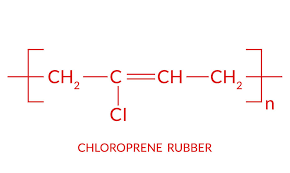Chloroprene rubber (CR) is one of the commonly used rubber varieties. The strength of vulcanized rubber without carbon black reinforcement can reach 28MPa, and the relative elongation is about 800%. It has the characteristics of oil resistance, flame resistance, oxidation resistance and ozone resistance. It is soluble in benzene and chloroform. It swells slightly but does not dissolve in mineral oil and vegetable oil.

1. Progress in CR Technology Abroad
DuPont in the U.S. came up with a liquid method to make chloroprene from butadiene. This is safer than the gas method that was first used. It can produce higher yield products at a lower cost, improve safety, and reduce maintenance costs. In 1992, the company upgraded its monomer production line, moving from a single-loop control system to a computerized distributed control system.
Recent progress in CR post-processing tech is apparent in the developments related to spiral extrusion dehydration and drying. Chloroprene latex and coagulant go into a screw extruder that has a specific design. The coagulated latex removes most of the water in the dehydration section of the extruder by the back pressure. The success of this process has created conditions for the industrial production of CR and asphalt and CR and short fibers, thereby increasing the operational flexibility and being able to handle CR varieties with poor freezing film-forming and tape-forming properties. In 1992, DuPont launched a series of elastomer masterbatches including CR with Kevlar (polyarylamide) short fibers as reinforcement materials, proving that this process has begun to be used in the production of blended products.
There are hundreds of foreign brands. Companies in the United States and Japan have developed many high-performance special CR based on a series of mature brands. In order to improve the thermal stability of CR, Bayer has developed copolymers of chloroprene (CD) with carboxylic acid amide, carboxylic acid anhydride and (or) carboxylic acid monomers. These new CR also have better spraying and brushing characteristics. Denka Corporation of Japan has also improved traditional products and launched a new generation of CR (Denka chloroprene rubber). For example, the DCR 20 series. Tosoh Corporation of Japan is also developing special shock-absorbing CR, and has produced CR latexes with high softening temperature, good normal temperature and high temperature adhesive properties, high water resistance and stability (SKYPRENE Chloroprene Rubber).
2. Progress in domestic CR technology
In 1958, Changshou Chemical Plant in Sichuan, my country built a device for producing CR by acetylene. The main CR production in China does not control the conversion rate, and many places use manual operations, which is basically a workshop-style production status. Besides the earlier producers of CR glue like Chongqing Changshou Chemical Co., Ltd., Shanxi Synthetic Rubber Company, Jiangsu Lianshui Chemical General Plant, and Tianjin Donghai Adhesives Company, Shandong Laizhou Kangbaili Glue Industry Co., Ltd. developed in October 2003 a new CR glue. They carefully chose and mixed the composite solvent.
3. Suggestions for the development of domestic CR industry
For domestic carbon black firms, boosting investment in science and tech, along with adopting and assimilating advanced foreign tech, is key. These actions should lower consumption and costs, and it should raise acetylene use from 57% to over 70% quickly.
To maintain the Mooney viscosity in current products, we will create new types. The focus will be on making functional latex, like carboxyl and copolymer latex. Our goal is to bring high Mooney, non-sulfur regulated WHV to industrial production.
In the next few years, the market of CR in my country will be saturated, and relevant manufacturers can consider developing overseas markets. At present, the development trend of CR in the world is that the European and American markets are shrinking, while China, Eastern Europe, Russia and Southeast Asia are in the rising stage. CR can not only contend with imported goods locally, but can also progressively expand sales to North America, Eastern Europe, Russia, East Asia, and Southeast Asia.
Website: www.elephchem.com
Whatsapp: (+)86 13851435272
E-mail: admin@elephchem.com